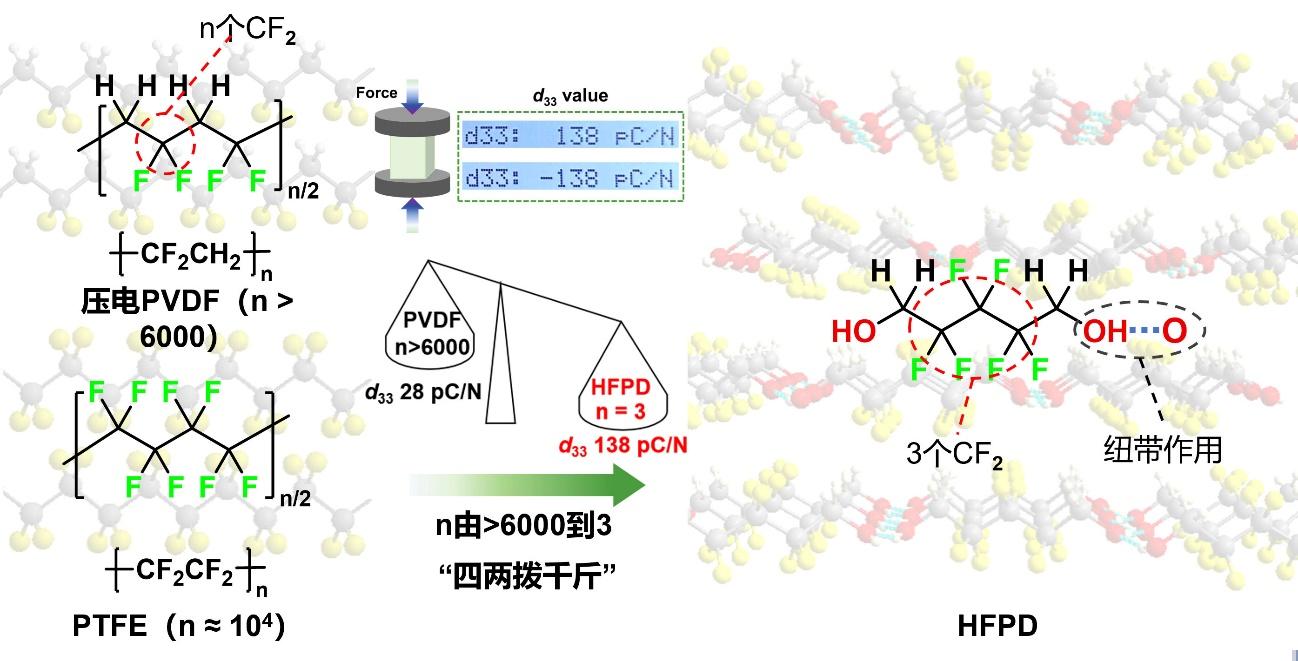On March 29th, Professor TANG Yuanyuan from the Ordered Matter Science Research Center at Nanchang University, in collaboration with researchers from Southeast University, published a research article titled "Biodegradable ferroelectric molecular crystal with large piezoelectric response" in the journal Science. The study reports a breakthrough in molecular crystals piezoelectricity(Science 2024,383, 1492-1498. Professor TANG Yuanyuan is one of the co-first authors (ranked second), with NCU as the first author affiliation.
With the continuous development of science and technology in our country, there is an increasing demand for medical and health care services. In this context, research on implantable piezoelectric biomedical devices is flourishing, and is expected to bring significant improvements to people's quality of life. Currently, the mainstream materials used in piezoelectric applications mainly rely on inorganic ferroelectric ceramics and ferroelectric polymers. However, these traditional materials have a major problem- they are non-biodegradable. This means that when electronic devices made of these materials are applied to the human body, a second surgery is required to remove them, undoubtedly increasing risks and inconveniences for patients. In contrast, ferroelectric molecular crystals stand out with their unique advantages. They are easily synthesized and processed in solution while possessing lightweight properties, excellent biocompatibility, and adjustable physical performance. Therefore, ferroelectric molecular crystals are considered ideal candidate materials for implantable transient piezoelectric devices. However, currently there is a scarcity of biodegradable ferroelectric molecular crystals in the market, and their piezoelectric performance is not satisfactory, with a generally low piezoelectric response d33 below 10 pC/N. Therefore, how to break through this technological bottleneck and develop ferroelectric molecular crystals that possess both high piezoelectric performance and biodegradability has become a key issue waiting to be solved in this field.
Combining crystal engineering with the ferroelectric chemical concept pioneered by Professor XIONG Rengen, Professor TANG’s team mimicked the β-phase structure of polyvinylidene fluoride (PVDF) and selected 2,2,3,3,4,4-hexafluoro-1,5-pentanediol (HFPD) as a ferroelectric molecular crystal and anchored -CH2OH groups at both ends of a limited odd number of -CF2- units. Through hydrogen bonding interactions resembling bonds in a chain-like fashion, an infinitely long chain structure (Figure 1) was developed. It is worth mentioning that by reducing the number of -CF2- structural units (n) from thousands to just three in PVDF, the team achieved a well-leveraged effect in small molecule piezoelectric performance (with d33 being 138 pC/N), demonstrating significant impact despite its smaller size (Figure 1). This discovery has pushed the piezoelectric performance of implantable piezoelectric materials to new heights. In the HFPD crystal, a unique two-dimensional hydrogen bond network is formed through the interaction of adjacent molecules via O–H···O hydrogen bonds. This characteristic allows the HFPD crystal to easily dissolve in various solvents, especially bodily fluids, which is highly advantageous for the degradation process of compounds within living organisms. Furthermore, this compound exhibits excellent biocompatibility and biodegradability, providing vast prospects for its application in the field of biomedical healthcare. Considering the brittleness and rigidity of crystals, the team prepared a flexible piezoelectric composite film consisting of HFPD-polyvinyl alcohol (PVA) with a d33 value of 34.3 pC/N using solution evaporation method. Based on this piezoelectric composite film, the team also assembled a controllable transient electromechanical device and confirmed its excellent biosensing performance. This achievement not only offers promising candidate materials for transient implantable electronic medical devices but also opens up new important ways for molecular piezoelectric materials in the field of human healthcare.

Figure 1. The well-leveraged design concept of high-voltage electrically biodegradable ferroelectrics.
Inspired by the concept of simplicity, the research team replaced the lengthy and complex infinite structural units in piezoelectric polymers with n = 3, successfully constructing high-pressure ferroelectric molecular crystals with excellent biodegradable properties. This research was highly praised by the reviewers as a key milestone for transient implantable piezoelectric materials and was introduced and highlighted as a milestone in piezoelectricmaterial development in the Perspective of Science(Science 2024,383, 1416)
Article link:https://www.science.org/doi/10.1126/science.adj1946
Editor: Cheng Huiping
Executive Editor: Tu Jinfeng